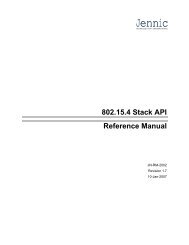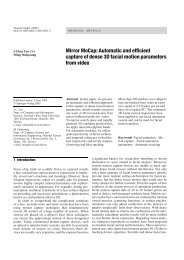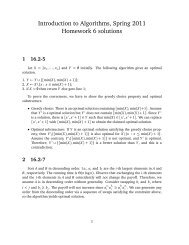Real-Time Translucent Rendering Using GPU-based Texture Space ...
Real-Time Translucent Rendering Using GPU-based Texture Space ...
Real-Time Translucent Rendering Using GPU-based Texture Space ...
You also want an ePaper? Increase the reach of your titles
YUMPU automatically turns print PDFs into web optimized ePapers that Google loves.
EUROGRAPHICS 2008 / Volume 27 (2008), Number 2<br />
<strong>Real</strong>-<strong>Time</strong> <strong>Translucent</strong> <strong>Rendering</strong> <strong>Using</strong> <strong>GPU</strong>-<strong>based</strong> <strong>Texture</strong><br />
<strong>Space</strong> Importance Sampling<br />
Chih-Wen Chang, Wen-Chieh Lin, Tan-Chi Ho, Tsung-Shian Huang and Jung-Hong Chuang<br />
Department of Computer Science, National Chiao Tung University, Taiwan<br />
Abstract<br />
We present a novel approach for real-time rendering of translucent surfaces. The computation of subsurface scattering<br />
is performed by first converting the integration over the 3D model surface into an integration over a 2D<br />
texture space and then applying importance sampling <strong>based</strong> on the irradiance stored in the texture. Such a conversion<br />
leads to a feasible <strong>GPU</strong> implementation and makes real-time frame rate possible. Our implementation shows<br />
that plausible images can be rendered in real time for complex translucent models with dynamic light and material<br />
properties. For objects with more apparent local effect, our approach generally requires more samples that may<br />
downgrade the frame rate. To deal with this case, we decompose the integration into two parts, one for local effect<br />
and the other for global effect, which are evaluated by the combination of available methods [DS03, MKB ∗ 03a]<br />
and our texture space importance sampling, respectively. Such a hybrid scheme is able to steadily render the<br />
translucent effect in real time with a fixed amount of samples.<br />
Keyword: BSSRDF, <strong>Translucent</strong> <strong>Rendering</strong>, <strong>Texture</strong> <strong>Space</strong> Importance Sampling<br />
1. Introduction<br />
<strong>Translucent</strong> materials are commonly seen in real world, e.g.,<br />
snow, leaves, paper, wax, human skin, marble, and jade.<br />
When light transmits into a translucent object, it can be absorbed<br />
and scattered inside the object. This phenomenon is<br />
called subsurface scattering. Subsurface scattering diffuses<br />
the scattered light and blurs the appearance of geometry details,<br />
which is known as local effect. Therefore, the appearance<br />
of translucent materials often looks smooth and soft,<br />
which is a distinct feature of translucent materials. Additionally,<br />
in some cases, light can pass through a translucent<br />
object and light the object from behind, which is known as<br />
global effect. These visual phenomena require accurate simulation<br />
of subsurface scattering and make rendering translucent<br />
objects a very complicate and important problem in<br />
computer graphics.<br />
Lambertian diffuse reflection or Bidirectional Reflection<br />
Distribution Function (BRDF) considers the case that light<br />
striking a surface point gets reflected at the same point.<br />
Nicodemus et al. [NRH ∗ 22] proposed Bidirectional Scattering<br />
Surface Reflection Distribution Function (BSSRDF) that<br />
considers the light scattering relation between the incident<br />
flux at a point and the outgoing radiance at another point<br />
on the surface. They formulated the subsurface scattering<br />
equation without providing an analytic solution. Hanrahan<br />
and Krueger [HK93] first proposed a method for simulating<br />
subsurface scattering by tracing light rays inside an object.<br />
Their approach, however, can only be applied to thin objects,<br />
such as leaf and paper; Light scattering in thick objects is too<br />
complicated to be fully traced.<br />
Recently, Jensen et al. [JMLH01] proposed an analytic<br />
and complete BSSRDF model, in which BSSRDF is divided<br />
into a single scattering term and a multiple scattering term.<br />
Single scattering term is contributed by light that scatters<br />
only once inside an object; Light rays that scatter more than<br />
once contribute to the multiple scattering term. Jensen et<br />
al. approximated the multiple scattering term as a dipole<br />
diffusion process. The diffusion approximation works well<br />
in practice for highly scattering media where ray tracing is<br />
computationally expensive [HK93, Sta95]. This approach is<br />
much faster than Monte Carlo ray tracing, because the scattering<br />
effect is evaluated without simulating the light scattering<br />
inside the model.<br />
Several recent papers exploit the diffusion<br />
approximation to render translucent materials<br />
[CHH03, DS03, HBV03, HV04, JB02, LGB ∗ 02, KLC06,<br />
c○ 2008 The Author(s)<br />
Journal compilation c○ 2008 The Eurographics Association and Blackwell Publishing Ltd.<br />
Published by Blackwell Publishing, 9600 Garsington Road, Oxford OX4 2DQ, UK and<br />
350 Main Street, Malden, MA 02148, USA.
C.-W. Chang et al. / <strong>Real</strong>-<strong>Time</strong> <strong>Translucent</strong> <strong>Rendering</strong><br />
MKB ∗ 03a, MKB ∗ 03b, WTL05]. Jensen and Buhler [JB02]<br />
proposed a two-stage hierarchical rendering technique to<br />
efficiently render translucent materials in interactive frame<br />
rate with acceptable error bound. Keng et al. [KLC06] further<br />
improved this approach using a cache scheme. Lensch<br />
et al. [LGB ∗ 02] modified Jensen’s formulation as a vertexto-vertex<br />
throughput formulation, which is precomputed and<br />
used for rendering at run-time. Carr et al. [CHH03] further<br />
improved this approach by using parallel computation and<br />
graphics hardware. In [HBV03, HV04], the contribution of<br />
light from every possible incoming direction is precomputed<br />
and compressed using spherical harmonics. With the<br />
precomputation, images can be rendered in real-time frame<br />
rate. Wang et al. [WTL05] presented a technique for interactive<br />
rendering of translucent objects under all-frequency<br />
environment maps. The equations of single and multiple<br />
scattering terms are reformulated <strong>based</strong> on the precomputed<br />
light transport.<br />
Although precomputed schemes can achieve real-time<br />
performance, they require extensive precomputation and<br />
extra storage for the results. To avoid the extensive precomputation,<br />
Mertens et al. [MKB ∗ 03a] and Dachsbacher<br />
and Stamminger [DS03] proposed image-<strong>based</strong> schemes for<br />
computing translucent effects in real-time without precomputation.<br />
The method by Mertens et al. [MKB ∗ 03a] renders<br />
the irradiance image from camera view and evaluates<br />
the local subsurface scattering by sampling the irradiance<br />
in a small area around the outgoing point. Dachsbacher and<br />
Stamminger [DS03] extended the concept of shadow map by<br />
first rendering the irradiance image from light view and then<br />
evaluating translucent effects by applying filtering around<br />
the projected outgoing point on irradiance image. This approach<br />
can catch both local and global subsurface scattering,<br />
but the effects of global subsurface scattering are inaccurate<br />
because only an area of single incident point, rather than all<br />
incident points, is taken into account.<br />
The most costly operation in rendering translucent objects<br />
is sampling over a model surface, which is hard to be implemented<br />
on graphics hardware. The texture map has been<br />
used to store surface properties and its operations are well<br />
supported by graphics hardware. Through a proper mesh parameterization,<br />
a bijective mapping between object surface<br />
and texture space can be assured, and hence the sampling<br />
over the texture space can be considered to be equivalent to<br />
the sampling over the model surface.<br />
In this paper, we propose a real-time translucency rendering<br />
approach for homogeneous materials. Our framework<br />
performs importance sampling over the texture space using<br />
graphics hardware. We first convert the integration over a 3D<br />
model surface into an integration over the 2D texture space,<br />
and then do the importance sampling <strong>based</strong> on the irradiance<br />
to compute translucent rendering. Our experiments have depicted<br />
that plausible images can be rendered in real time for<br />
many complex translucent models with dynamic light and<br />
material properties.<br />
For objects with more apparent local effect, higher number<br />
of samples is generally required to generate accurate<br />
images for translucent rendering. For such objects, the proposed<br />
texture space importance sampling may require more<br />
samples than the cases in which global effect is more apparent.<br />
To deal with such cases, we propose a hybrid approach<br />
that decomposes the integration into two parts, one for local<br />
effect and the other for global effect, and evaluate the<br />
local and global effects using the translucent shadow map<br />
approach [DS03,MKB ∗ 03a] and the proposed texture space<br />
importance sampling, respectively. Such a hybrid scheme is<br />
able to steadily render the translucent effect in real time with<br />
a fixed amount of samples.<br />
2. <strong>Translucent</strong> <strong>Rendering</strong> <strong>Using</strong> <strong>Texture</strong> <strong>Space</strong><br />
Importance Sampling<br />
2.1. BSSRDF and Dipole Approximation<br />
The scattering of light in translucent materials is described<br />
by the Bidirectional Surface Scattering Reflection Distribution<br />
Function(BSSRDF) [NRH ∗ 22]:<br />
S(x i , −→ ω i ,x o, −→ ω o) = dL(xo,−→ ω o)<br />
dΦ(x i , −→ ω i ) ,<br />
where L is the outgoing radiance, Φ is the incident flux, and<br />
−→ ωi and −→ ω o are incoming and outgoing direction of the light at<br />
the incoming and outgoing position x i and x o, respectively.<br />
In order to compute the shading of translucent materials, the<br />
following integral needs to be computed :<br />
L(x o, −→ ω o) = R R<br />
A Ω +<br />
L i (x i , −→ ω i )S(x i , −→ ω i ,x o, −→ ω −→ o)| N i · −→ ω i |d −→ ω i dx i (1)<br />
where A is the surface of the object, Ω + is the hemisphere<br />
positioned at the incoming position x i , −→ N i is the normal direction<br />
at x i , and L(x o, −→ ω o) is the outgoing radiance. By solving<br />
this equation, subsurface scattering can be simulated.<br />
S(x i , −→ ω i ,x o, −→ ω o) is an eight-dimensional function relating<br />
incident flux and outgoing radiance. It is not easy to efficiently<br />
precompute and store BSSRDF in memory because<br />
of the high dimensionality, especially when surface geometry<br />
is complicated. Jensen and Buhler [JB02] have shown<br />
that when the single scattering term is ignored, BSSRDF<br />
with multiple scattering term can be presented as a fourdimensional<br />
function R d (x i ,x o). Taking into account the<br />
Fresnel transmittance F t(η, −→ ω ) results in the following function<br />
S(x i , −→ ω i ,x o, −→ ω o) = 1 π Ft(η,−→ ω o)R d (x i ,x o)F t(η, −→ ω i ).<br />
Substituting this into Equation 1 yields<br />
L(x o, −→ ω o) = 1 π Ft(η,−→ ω o)B(x o), (2)<br />
c○ 2008 The Author(s)<br />
Journal compilation c○ 2008 The Eurographics Association and Blackwell Publishing Ltd.
where<br />
Z<br />
B(x o) = E(x i )R d (x i ,x o)dx i (3)<br />
A<br />
is the outgoing radiosity, and<br />
Z<br />
E(x i ) = L i (x i , −→ ω i )F t(η, −→ ω i )| −→ N i · −→ ω i |d −→ ω i (4)<br />
Ω +<br />
is the irradiance. Note that R d (x i ,x o) is the diffusion function<br />
approximated by the dipole diffusion equation shown in<br />
Table 1 [JMLH01].<br />
C.-W. Chang et al. / <strong>Real</strong>-<strong>Time</strong> <strong>Translucent</strong> <strong>Rendering</strong><br />
R d (x i ,x 0 ) = α′<br />
4π [z r(1+σ tr s r ) e−σ tr s r<br />
s 3 r<br />
r = ‖x o − x i ‖<br />
z r = 1/σ t<br />
′<br />
z v = z r(1+4A/3)<br />
s r = √ z 2 r + r 2<br />
s v = √ z 2 v + r 2<br />
A = 1+F dr<br />
1−F dr<br />
Fdr = − 1.440 + 0.710<br />
η 2 η + 0.668+0.0636η<br />
σ tr = √ 3σ aσ t<br />
′<br />
σ t ′ = σ a + σ ′ s<br />
α ′ = σ ′ s/σ t<br />
′<br />
σ ′ s : reduced scattering coefficient<br />
σ a : absorption coefficient<br />
η : relative refraction index<br />
+ z v (1+σ tr s v ) e−σ tr s v<br />
]<br />
Sv<br />
3<br />
Table 1: The dipole diffusion equation for BSSRDF model.<br />
These equations describe the properties of local and<br />
global subsurface scattering. The outgoing radiosity is contributed<br />
by the integration of irradiance and the diffusion<br />
function R d (x i ,x o). The value of diffusion function falls off<br />
rapidly as the distance ‖x i − x o‖ increases. In consequence,<br />
the integration for the outgoing radiosity is mostly contributed<br />
by the points in the nearby area of the outgoing point<br />
that is visible to the light source. This is termed as the local<br />
subsurface scattering. When the outgoing point is invisible<br />
to the light source, the irradiance in the nearby area is low<br />
and the outgoing radiosity is instead gathered from a farther<br />
area that is visible to the light source. This feature is termed<br />
as the global surface scattering.<br />
2.2. <strong>Texture</strong> <strong>Space</strong> Importance Sampling<br />
Computing the integration for outgoing radiance by sampling<br />
over the object surface is usually computationally expensive.<br />
Therefore, we first construct a bijective mapping<br />
from object surface to the texture space using mesh parameterization<br />
and then do the sampling on the texture space.<br />
Performing importance sampling over the texture space to<br />
compute the integration is more efficient and can be greatly<br />
accelerated by graphics hardware.<br />
In the following, we explain how to reformulate Equation<br />
3 in order to compute the integration over the texture space.<br />
Figure 1: The framework of proposed approach.<br />
Since the input model is a triangle mesh, the integration can<br />
be represented as summation over triangle faces as follows :<br />
B(x o) =<br />
Z<br />
N F<br />
∑<br />
j=1<br />
F j<br />
E(x i )R d (x i ,x o)dx i , (5)<br />
where N F is the total number of triangle faces and F j is the<br />
the jth triangle face.<br />
After parameterization, each triangle face will be associated<br />
with a unique texture coordinate. In theory, we can<br />
directly map a triangle face to texture space. However, triangles<br />
may be shrunk or enlarged during the parameterization<br />
process. In order to obtain correct integration result, we scale<br />
the area of each triangle face in the integration:<br />
N F<br />
A j Z<br />
S<br />
B(x o) = ∑<br />
j=1 A j E(x i )R d (x i ,x o)dx i , (6)<br />
T<br />
T j<br />
where A j S and A j T are area of the triangle face j on 3D model<br />
surface and 2D texture space, respectively, and T j is the jth<br />
triangle face on the texture space. Note that theoretically<br />
Equation 6 is only valid when the parameterization is with<br />
constant jacobian; however, from our experiments, we found<br />
that translucent rendering results do not vary much whether<br />
this assumption holds or not.<br />
Since the object surface is usually segmented into patches<br />
to reduce the parameterization distortion, the texture map<br />
is formed by packing a set of atlases, each of which corresponds<br />
to a patch. Among atlases, there is empty space. In<br />
c○ 2008 The Author(s)<br />
Journal compilation c○ 2008 The Eurographics Association and Blackwell Publishing Ltd.
C.-W. Chang et al. / <strong>Real</strong>-<strong>Time</strong> <strong>Translucent</strong> <strong>Rendering</strong><br />
the empty space, the area of triangle A j S and irradiance E(x i)<br />
are considered as both zero. Therefore, the integration can<br />
be evaluated over the whole texture space as follows:<br />
B(x o) = ∑ NF A j R<br />
S<br />
j=1 A j T j<br />
E(x i )R d (x i ,x o)dx i<br />
T<br />
= R T E′ (x i )R d (x i ,x o)dx i ,<br />
where T is the texture space of the model surface, and<br />
E ′ (x i ) = A j S E(x i)/A j T is the product of the irradiance term<br />
and the area scaling term.<br />
Next, we describe how to evaluate Equation 7 using importance<br />
sampling [DBB02, KW86]. Importance sampling<br />
approximates an integral by the weighted mean of the integrand<br />
values that are sampled over the integration domain<br />
D:<br />
Z<br />
f(x)dx ≈ 1 N<br />
f(x<br />
D N<br />
∑<br />
i )<br />
i=1 p(x i ) , (8)<br />
where the samples x i are generated according to a probability<br />
density function p(x) whose value is high when f(x) is large;<br />
there are more samples in important regions.<br />
We need to define an appropriate probability density function<br />
to render translucency. In our case, the integrand f is<br />
the product of irradiance function E ′ (x i ) and diffusion function<br />
R d (x i ,x o). If we perform importance sampling <strong>based</strong><br />
on E ′ (x i )R d (x i ,x o), precomputation at every outgoing point<br />
is required since the distance and neighboring relation between<br />
triangles on the 3D model surface is lost in the 2D texture<br />
space after parameterization. This is against our goal of<br />
rendering translucency with low precomputation overhead.<br />
Therefore, we define p(x i ) over texture space to be proportional<br />
to the value of the irradiance function E ′ (x i ):<br />
(7)<br />
p(x i ) = E ′ (x i )/E ′ avg, (9)<br />
where E ′ avg = R T E′ (x)dx is the integration of irradiance over<br />
texture space. With N samples distributed <strong>based</strong> on p(x i ), the<br />
integration of outgoing radiosity can be rewritten as<br />
B(x o) ≈ 1 N ∑N i=1 E′ (x i)R d (x i,x o)<br />
p(x i)<br />
(10)<br />
= E′ avg<br />
N ∑N i=1 R d(x i ,x o).<br />
Note that samples generated according to irradiance can now<br />
be shared for different outgoing points since the irradiance<br />
function in Equation 7 only depends on incident positions.<br />
3. Implementation on <strong>GPU</strong><br />
In this section, we describe implementation details of our approach.<br />
As shown in Figure 1, the proposed approach consists<br />
of a precomputation process and a three-stage <strong>GPU</strong><strong>based</strong><br />
translucent rendering process. In precomputation, parameterization<br />
is applied to an input mesh and a normal map<br />
is derived. To avoid the undersampling problem, area preserving<br />
or signal-specialized parameterization is preferred.<br />
In our implementation, an area-preserving parameterization<br />
method proposed by Yoshizawa et al. [YBS04] is used.<br />
The three-stage run-time process includes rendering the<br />
irradiance to a texture map, performing importance sampling<br />
according to the irradiance, and evaluating the the outgoing<br />
radiance <strong>based</strong> on the generated samples. Tone reproduction<br />
is applied before the final translucent images are output. We<br />
implemented the run-time process on <strong>GPU</strong> using OpenGL,<br />
OpenGL extension, shading language, and shader model 2.0.<br />
<strong>Rendering</strong> Irradiance to <strong>Texture</strong><br />
At the first stage, we render the irradiance E ′ (x i ) =<br />
A j S E(x i)/A j T into a texture map. In our implementation, point<br />
light sources are used. We evaluate the irradiance on the<br />
model surface in pixel shader and render it into the associated<br />
texture coordinate. In addition, 3D position x i is rendered<br />
to another texture map.<br />
Importance Sampling<br />
In the second stage, N samples are distributed over the<br />
texture space according to Equation 9. We apply the inverse<br />
cumulative distribution function (ICDF) to determine the location<br />
of each sample. CDF is a function that accumulates<br />
the values of the probability density function in sequence,<br />
and is defined as F(x i ) = R x i<br />
z 0<br />
p(z)dz, where z 0 is the beginning<br />
of the sequence. Samples are generated according to<br />
p(x) by solving F(x i ) = y for the values of y uniformly sampled<br />
over the interval [0,1). To exploit <strong>GPU</strong> acceleration to<br />
speed up the process, we store each sample as a pixel of<br />
screen with assigned probability y, use pixel shader to compute<br />
ICDF, and finally output the resultant sample positions<br />
into a texture map.<br />
Conventionally, row-major order is used for computing<br />
CDF on <strong>GPU</strong>. Figure 2(a) shows a row-major order on a 4x4<br />
texture map, on which the inverse function F −1 (u) can usually<br />
be derived by a binary search over the data structure. The<br />
row-major order, however, does not fully utilize the parallel<br />
computational power of <strong>GPU</strong>. We propose a mipmap-<strong>based</strong><br />
order as shown in Figure 2(b), in which the cumulation process<br />
can be performed using the mipmapping hardware of<br />
<strong>GPU</strong>. For each sample, the inverse function F −1 (u) is derived<br />
by traversing the mipmap structure from the top level<br />
to the lowest level. Since the evaluation of inverse function<br />
can be performed independently, samples can be generated<br />
in pixel shader.<br />
Evaluating Translucency<br />
After generating N samples, we evaluate the outgoing radiance<br />
for each point on the model surface. For each rendered<br />
pixel, we fetch all samples by a 2D texture lookup<br />
and sum up the contribution from these samples. Combining<br />
Equations 2 and 10 yields the following equation for computing<br />
outgoing radiance<br />
L(x o, −→ ω o) = Ft(η,−→ ω o)E ′ avg<br />
Nπ<br />
N<br />
∑ R d (x i ,x o). (11)<br />
i=1<br />
The diffusion function R d (x i ,x o) and the Fresnel transmittance<br />
F t(η, −→ ω o) contain computation of trigonometry,<br />
c○ 2008 The Author(s)<br />
Journal compilation c○ 2008 The Eurographics Association and Blackwell Publishing Ltd.
C.-W. Chang et al. / <strong>Real</strong>-<strong>Time</strong> <strong>Translucent</strong> <strong>Rendering</strong><br />
(a) Row-major Order<br />
(b) Mipmap-<strong>based</strong> Order<br />
Figure 2: Two different data orders for evaluating cumulative<br />
distribution function: Row-major order and mipmap<strong>based</strong><br />
order.<br />
square root, and exponential function, which are complicated<br />
instructions. To facilitate <strong>GPU</strong> programming, we store<br />
R d (x i ,x o) and F t(η, −→ ω o) into texture maps and evaluate<br />
the functions by texture lookup. According to the equation<br />
shown in Table 1, R d (x i ,x o) can be represented as a onedimensional<br />
function,<br />
R d (x i ,x o) = R d (r),<br />
where r = ‖x o − x i ‖ is the distance between the incident and<br />
the outgoing point. We normalize the diagonal length of the<br />
input object to 1 and store the diffusion function R d (r) as<br />
a one-dimensional texture over interval [0,1]. The Fresnel<br />
transmittance F t(η, −→ ω o) is also stored as a one-dimensional<br />
texture using the dot product of normal and view direction<br />
as the indexing parameter.<br />
After computing outgoing radiance, we transform the radiance<br />
to color using DirectX’s HDR Lighting, which is a<br />
tone mapping algorithm commonly used in real-time high<br />
dynamic range lighting. We approximate the average radiance<br />
Radiance avg of rendered pixels by the average irradiance<br />
E ′ avg computed at the second stage. Therefore, we can<br />
integrate the tone mapping into the final stage without additional<br />
passes. The equations for computing the tone mapping<br />
are as follows:<br />
Radiance scale (x,y) = Radiance(x,y)<br />
Radiance avg<br />
Color(x,y) = 1+Radiance scale(x,y)<br />
Radiance scale (x,y) .<br />
After the tone mapping, we add the Phong-<strong>based</strong> specular<br />
effect to the final image.<br />
4. Hybrid Method<br />
The diffusion function is the most costly to sample for<br />
translucent rendering since it depends on the lighting from<br />
a large fraction of the model surface. Jensen and Buhler<br />
[JB02] evaluated the integration by a uniform sampling over<br />
the model surface. In order to have sufficient number of samples<br />
to generate quality results, the mean-free path l u is used<br />
as the maximal distance between neighboring samples and<br />
l u = 1/σ ′ t is the average distance at which the light is scattered.<br />
As a result, for a given object, the required number<br />
of samples is approximately A/(πl 2 u), where A is the surface<br />
area of the object. The required number of samples will be<br />
higher for objects with larger value of σ ′ t or larger size. In<br />
this case, the local translucency is the dominant rendering<br />
effect.<br />
The aforementioned problem also happens in our texture<br />
space importance sampling method. In order to deal with<br />
this problem, we proposed a hybrid approach that first decomposes<br />
the integration equation into two parts, one for<br />
local effect and the other for global effect. We then evaluate<br />
the local and global effects using the translucent shadow<br />
map [DS03] and the proposed texture space importance sampling,<br />
respectively.<br />
4.1. Decomposition of Diffusion Function R d (r)<br />
We decompose the diffusion function R d (r) into a local term<br />
and a global term:<br />
R d (r) = R d (r)W l (r)+R d (r)W g(r),<br />
where W l (r) and W g(r) are weighting functions defined by<br />
W l (r) = { 1.0 − 0.5e−(r−Rp)·K r ≤ R p<br />
0.5e −(r−Rp)·K r > R p<br />
,<br />
W g(r) = 1.0 −W l (r),<br />
where R p is the distance at which the contributions of the<br />
global and local term are equal and K = 1.5 is a constant.<br />
The outgoing radiosity B(x o) in Equation 3 can then be reformulated<br />
as follows:<br />
B(x o) = R A E(x i)R d (x i ,x o)dx i<br />
= R A E(x i)R d (r)(W l (r)+W g(r))dx i<br />
= R A E(x i)R d (r)W l (r)dx i + R A E(x i)R d (r)W g(r)dx i<br />
= B l (x o)+B g(x o)<br />
Figure 3 shows an example of weighting function, and the<br />
decomposed diffusion functions, R l d (r) = R d(r)W l (r) and<br />
R g d (r) = R d(r)W g(r). Notice that, as shown in Figure 3(b),<br />
the function value of small distance r is retained in the local<br />
term while the global term preserves the function value for<br />
large distance r.<br />
Choosing an appropriate R p value is important. The global<br />
term will still contain the distinct local effect if R p is too<br />
small, and leave nothing if R p is too large. In the following,<br />
we describe a method to choose R p. We first define an<br />
importance function as the product of the diffusion function<br />
and the circumference of a circle of radius r:<br />
R Imp<br />
d (r) = R d (r) ∗ 2πr,<br />
and find the intersections of y = R Imp<br />
d (r) and y = c for RGB<br />
channels, where c is the value of a user-specified importance<br />
.<br />
c○ 2008 The Author(s)<br />
Journal compilation c○ 2008 The Eurographics Association and Blackwell Publishing Ltd.
C.-W. Chang et al. / <strong>Real</strong>-<strong>Time</strong> <strong>Translucent</strong> <strong>Rendering</strong><br />
(a) W l (r) and W g(r)<br />
(b) R d (r), R l d (r), and Rg d (r)<br />
Figure 3: Graphs of weighting function and diffusion function<br />
for red channel of Skimmilk material [JMLH01] (σ a is<br />
0.0024, σ ′ s is 0.70, and η is 1.3). R p is 2.4141.<br />
(a)<br />
(b)<br />
lower bound. The largest intersection point is then chosen as<br />
R p. Figure 4 illustrates choosing R p for skimmilk material.<br />
(c) Full (d) Local (e) Global<br />
Figure 5: (a) Irradiance map rendered from the light view.<br />
(b) Circular filtering pattern with 17 (= 4 · 4+1) samples.<br />
Images with (c) full R d function, (d) local R l d function, and<br />
(e) global R g d function. Model is 10mm MaxPlanck and material<br />
is skimmilk.<br />
Figure 4: Determining R p for skimmilk material.<br />
4.2. Computing Local Translucency<br />
We modified the translucent shadow map approach proposed<br />
in [DS03] to compute the local translucency. <strong>Translucent</strong><br />
shadow map approach renders an irradiance map on the projection<br />
plane viewed from the light source and computes<br />
translucency by applying filtering on the irradiance map. We<br />
replaced the fixed filtering pattern with 21 samples proposed<br />
in [DS03] by a circular filtering pattern with L ·C + 1 samples,<br />
where L is the number of concentric circles and C is<br />
the number of samples uniformly distributed in each circular<br />
ring. The radii of concentric circles are determined by<br />
applying the importance sampling on the projection plane as<br />
proposed by Mertens et al. [MKB ∗ 03a]. The circular filtering<br />
pattern makes sampling isotropic and can easily control<br />
the sampling density according to the radius. Figure 5(a)(b)<br />
shows an circular filtering pattern. An example of decomposition<br />
of global and local translucency is shown in Figure<br />
5(c)(d)(e).<br />
5. Experimental Results<br />
In this section, we show the results of the texture space importance<br />
sampling method and the hybrid method. We compare<br />
the proposed texture space importance sampling ap-<br />
proach with an interactive rendering approach [MKB ∗ 03a]<br />
and a non-real-time approach [JB02]. All experiments are<br />
performed on an Intel Core 2 Duo E6600 2.4GHz PC with<br />
NVIDIA Geforece 8800 GTX graphics hardware. All images<br />
are rendered in 512 × 512 screen resolution except that<br />
those in Figure 11 are rendered in 300 × 300 screen resolution.<br />
The scattering parameters for different materials used<br />
in our experiments are adopted from Figure 5 of [JMLH01].<br />
5.1. <strong>Texture</strong> <strong>Space</strong> Importance Sampling<br />
Table 2 and 3 show the performance of the texture space<br />
importance sampling method using an irradiance map with<br />
1024 × 1024 resolution. Table 2 measures the frame rate in<br />
the run-time process. If lighting and material are fixed, then<br />
only the third stage of the run-time process needs to be recomputed<br />
when view changes. In this situation, higher frame<br />
rate can be achieved as shown in Table 3. Note that material<br />
properties only affect the content of R d (r), which is<br />
stored as a 1D texture. The performance of our algorithm<br />
mainly depends on the number of samples and rendered pixels.<br />
One can observe from Table 2 and 3 that the computational<br />
time is roughly proportional to the number of samples.<br />
The resolution of geometry also has influence to the performance;<br />
models with fewer triangles are rendered faster, e.g.,<br />
the Cowhead example in the table. Result images of three<br />
cases in Table 3 are shown in Figure 6. Figure 7 shows that<br />
the RMSE decreases as number of samples increases in rendering<br />
a 30mm Santa model with skin2 material.<br />
We compare the proposed texture space importance sampling<br />
approach to an interactive rendering method proposed<br />
by Mertens et al. [MKB ∗ 03a]. Figure 8 compares images<br />
c○ 2008 The Author(s)<br />
Journal compilation c○ 2008 The Eurographics Association and Blackwell Publishing Ltd.
C.-W. Chang et al. / <strong>Real</strong>-<strong>Time</strong> <strong>Translucent</strong> <strong>Rendering</strong><br />
Number of Samples<br />
Model # of Triangles 49 100 169 256 400 900 1600 2500<br />
Sphere 28560 119.2 99.3 78.5 62.9 47.2 25.3 15.0 9.8<br />
CowHead 2072 156.6 142.7 126.9 110.4 91.5 57.1 37.0 25.2<br />
TexHead 8924 148.6 128.0 110.4 91.8 72.6 42.4 26.5 17.6<br />
MaxPlanck 9951 135.2 120.2 102.5 83.1 64.7 37.3 22.9 15.1<br />
Parasaur 7685 148.4 127.9 110.0 93.7 74.7 43.2 27.0 18.2<br />
Igea 10000 145.7 122.6 103.3 85.5 67.0 38.2 23.4 15.4<br />
Santa 10000 152.0 118.7 106.3 90.7 69.0 39.7 24.8 16.5<br />
Table 2: Performance of the entire run-time process for different models in frame per second (fps).<br />
Number of Samples<br />
Model # of Triangles 49 100 169 256 400 900 1600 2500<br />
Sphere 28560 449.3 242.4 150.2 101.2 66.0 29.9 16.6 10.4<br />
CowHead 2072 1144.9 634.1 408.6 278.1 181.7 82.9 46.4 29.1<br />
TexHead 8924 819.1 449.8 277.7 187.8 122.3 55.6 31.1 19.5<br />
MaxPlanck 9951 698.3 376.9 233.6 157.8 102.8 47.2 26.6 16.7<br />
Parasaur 7685 874.2 485.0 291.8 199.1 129.8 57.3 31.9 20.3<br />
Igea 10000 702.9 377.8 238.0 163.2 107.1 48.8 26.9 16.8<br />
Santa 10000 734.1 402.5 248.9 170.1 110.6 50.6 28.3 16.7<br />
Table 3: Performance of the integration stage (the third stage of run-time process) for different models in fps.<br />
Figure 6: Result images with settings in Table 3. (a) Max-<br />
Planck with skimmilk and 900 samples in 47.2 fps (b)<br />
Parasaur with skin1 and 1600 samples in 31.9 fps (c) Tex-<br />
Head with marble and 2500 samples in 19.5 fps.<br />
of 10mm Igea with marble material in different views. Because<br />
Mertens et al. rendered the irradiance map from camera<br />
view, irradiance is caught poorly when the camera turns<br />
to the other side of the light source (see the second column in<br />
Figure 8). Besides, Mertens et al. applied importance sampling<br />
over the projection plane <strong>based</strong> on the diffusion function<br />
R d (r), samples need to be regenerated for each rendered<br />
pixel and the contribution is scaled by the normal direction<br />
and depth of each sample. Therefore, their method needs<br />
more instructions in the final stage and the computation cost<br />
is about 10 times of our method.<br />
Figure 7: RMSE of 30mm Santa model rendered with skin 2<br />
material using different number of samples.<br />
Figure 8: Comparison with an interactive-rate rendering<br />
approach. Images in the top row are rendered by our method<br />
using 1600 samples in 26.9 fps. Images in the bottom row are<br />
rendered by the method of Mertens et al. [MKB ∗ 03a] under<br />
the same condition in 2.6 fps. Our method renders back-lit<br />
translucency correctly and its performace is 10 times faster.<br />
To quantitatively evaluate the image quality of our results,<br />
we also compare the proposed texture space importance<br />
sampling approach to a non-real-time method proposed<br />
by Jensen and Buhler [JB02]. Figure 9 and 10 show<br />
the images rendered by these two methods with different<br />
model scales and materials. In Figure 9(a)(c), 1600 samples<br />
are used and images are rendered in 19.9 fps. The root mean<br />
c○ 2008 The Author(s)<br />
Journal compilation c○ 2008 The Eurographics Association and Blackwell Publishing Ltd.
C.-W. Chang et al. / <strong>Real</strong>-<strong>Time</strong> <strong>Translucent</strong> <strong>Rendering</strong><br />
(a) Ours (skin1, 1600 samples)<br />
(b) Jensen & Buhler (skin1)<br />
(a) Ours (skin1, 2500 samples)<br />
(b) Jensen & Buhler (skin1)<br />
(c) Ours (skin2, 1600 samples)<br />
(d) Jensen & Buhler (skin2)<br />
Figure 9: Images of 10mm Igea rendered by our method and<br />
by Jensen and Buhler’s method [JB02].<br />
(c) Ours (skin2, 2500 samples)<br />
(d) Jensen & Buhler (skin2)<br />
Figure 10: Images of 30mm Santa rendered by our method<br />
and by Jensen and Buhler’s method [JB02].<br />
square error (RMSE) between images of these two methods<br />
are 0.0096 and 0.0098 for skin1 and skin2, respectively. In<br />
Figure 10(a)(c), 2500 samples are used and images are rendered<br />
in 16.5 fps. The RMSE between images of these two<br />
methods are 0.0138 and 0.0119 for skin1 and skin2, respectively.<br />
Figure 9(b)(d) and Figure 10(b)(d) are rendered by the<br />
non-real-time method [JB02] with a rapid hierarchical octree<br />
data structure under 0.3 error threshold in 0.016 fps.<br />
Our approach can render dynamic translucent materials<br />
by extending the 1D texture of the diffusion function R d (r)<br />
to a 2D texture. We linearly interpolate the scattering coefficients<br />
and the model size from one setting to another. Figure<br />
11(a) shows the result images of objects with dynamically<br />
varying model size. The number of samples and rendering<br />
speed in Figure 11(a) range from 400 to 48400 samples and<br />
140 to 1.1 fps respectively (from left to right images). In<br />
Figure 11(b), both model size and material are dynamically<br />
varied. 3600 samples are used in all images and rendering<br />
speed ranges from 150 to 18 fps.<br />
To study the effects of paramerization on our translucency<br />
rendering approach, we tested our approach with<br />
different parameterization methods. Our experiment shows<br />
that the RMSE of the rendering results of a 10mm IGEA<br />
model with skin1 material is 0.0124 for Floater’s non-areapreserving<br />
parameterization method [Flo97] and 0.0089<br />
for Yoshizawa’s area-preserving parameterization method<br />
[YBS04]. This suggests that for models without sharp geometric<br />
features, area-preserving parameterization generates<br />
slightly better results than non-preserving parameterization<br />
(a) (b) (c) (d)<br />
Figure 12: (b,c) Images of cow head with marble material.<br />
(a) <strong>Texture</strong> derived by Floater’s parameterization [Flo97].<br />
(d) <strong>Texture</strong> derived by an area-preserving parameterization<br />
proposed by Yushizawa et al. [YBS04]. There are significant<br />
errors around the horn in (b) due to the undersampling problem.<br />
does. For models with sharp corners, non-area-preserving<br />
parameterization may introduces the under-sampling problem.<br />
Figure 12(a) shows an example in which the areas of triangles<br />
around the horn are shrunk too much due to non-areapreserving<br />
parameterization. The under-sampling problem<br />
induces significant errors around the horn when compared<br />
with the result generated using Yoshizawa’s area-presering<br />
parameterization method as shown in Figure 12(c).<br />
5.2. Hybrid Method<br />
Our hybrid method decomposes the diffusion function into<br />
a local term and a global term. This decomposition ameliorates<br />
the problem that the required number of samples increases<br />
rapidly when local translucency effects dominate the<br />
c○ 2008 The Author(s)<br />
Journal compilation c○ 2008 The Eurographics Association and Blackwell Publishing Ltd.
C.-W. Chang et al. / <strong>Real</strong>-<strong>Time</strong> <strong>Translucent</strong> <strong>Rendering</strong><br />
(a) 10 mm skin1 to 70 mm skin1<br />
(b) 10 mm skimmilk to 40 mm skin1<br />
Figure 11: <strong>Rendering</strong> results of objects with (a) dynamically varying model size and (b) dynamically varying model size and<br />
material. The intermediate results are generated by linearly interpolating the model size and scattering coefficients.<br />
rendering results, either due to large model size or material<br />
properties. Figure 13 shows the rendered images of 10mm,<br />
20mm and 30mm Parasaur with skin1 material. The number<br />
of samples needed for good image quality increases to 14400<br />
in the texture space importance sampling method, while the<br />
hybrid method can achieve similar image quality with much<br />
fewer number of samples (compare (c) and (f) in Figure 13<br />
and 14). In the hybrid method, we use 900 samples and 401<br />
samples for the global and local effect, respectively. Since<br />
large L and C value would increase the rendering time while<br />
decreasing RMSE, we tested different values and found that<br />
L = C = 20 is a good compromise for the rendering speed<br />
and accuracy. Figure 14 is another example for three different<br />
materials: skin1, marble, and cream. <strong>Using</strong> images generated<br />
by Jensen and Buhler’s method [JB02] as the ground<br />
truth, the RMSE in Figure 14(a) and (d) are 0.0107 and<br />
0.0144, respectively. These results show that the rendering<br />
speed of our hybrid method can be maintained for different<br />
model sizes and object materials.<br />
6. Conclusion and Future Work<br />
In this paper, we have presented a <strong>GPU</strong>-<strong>based</strong> texture space<br />
importance sampling method for rendering translucent materials.<br />
The proposed method converts the integration over the<br />
model surface into an integration over a texture space. This<br />
conversion makes <strong>GPU</strong> implementation of importance sampling<br />
feasible such that translucency rendering with good accuracy<br />
can be archived in real-time. Our comparison experiments<br />
show that the proposed approach has faster speed and<br />
(a) 10mm 55.0fps (b) 20mm 13.4fps (c) 30mm 3.3fps<br />
900 samples 3600 samples 14400 samples<br />
(d) 10mm 17.3fps (e) 20mm 17.3fps (f) 30mm 17.3fps<br />
900+401 samples 900+401 samples 900+401 samples<br />
Figure 13: Images of Parasaur with skin1 material and<br />
varying model sizes. (a)(b)(c) are rendered by our texture<br />
space importance sampling method. (d)(e)(f) are rendered<br />
by our hybrid method.<br />
better back-lit translucency effects than the interactive-rate<br />
rendering approach proposed by Mertens et al. [MKB ∗ 03a].<br />
Moreover, the proposed texture space importance sampling<br />
approach achieves real-time frame rate (16 to 20 fps) with<br />
less than 0.014 RMSE when compared to Jensen and Buhler’s<br />
non-real-time approach [JB02].<br />
c○ 2008 The Author(s)<br />
Journal compilation c○ 2008 The Eurographics Association and Blackwell Publishing Ltd.
C.-W. Chang et al. / <strong>Real</strong>-<strong>Time</strong> <strong>Translucent</strong> <strong>Rendering</strong><br />
(a) skin1 18.2fps (b) marble 3.0fps (c) cream 0.6fps<br />
2500 samples 14400 samples 62500 samples<br />
(d) skin1 21.8fps (e) marble 21.6fps (f) cream 22.2fps<br />
900+401 samples 900+401 samples 900+401 samples<br />
Figure 14: Images of Santa with 30mm size and different<br />
materials. (a)(b)(c) are rendered by our texture space importance<br />
sampling method. (d)(e)(f) are rendered by our hybrid<br />
method.<br />
The proposed texture space importance sampling method<br />
may require more samples for objects with apparent local<br />
translucency effects. This problem also happens on approaches<br />
that apply uniform sampling on model surface<br />
[JB02]. We overcome this problem by proposing a hybrid<br />
method in which translucent rendering is decomposed into<br />
local part and global part. Our experiments show that the<br />
proposed hybrid method can effectively reduce number of<br />
samples and render translucency efficiently.<br />
In the future, we plan to exploit the temporal coherence<br />
to reduce the number of samples in rendering consecutive<br />
frames when the light source moves or the model size<br />
changes. Besides, area-preserving parameterization does not<br />
take the variation of irradiance value into account and hence<br />
may still introduce under-sampling problems. We will investigate<br />
how to incorporate the signal-specialized parameterization<br />
into our texture space importance sampling scheme.<br />
Furthermore, mesh dissection is often used to reduce the<br />
parameterization distortion. Issues regarding the importance<br />
sampling over texture atlas will also be investigated. Finally,<br />
we would like to explore the possibility to do importance<br />
sampling according to the product of irradiance and diffusion<br />
function. This is a more challenging problem for realtime<br />
translucent rendering, but might lead to a unified approach<br />
that is capable of handling both local and global<br />
translucent effect.<br />
References<br />
[CHH03] CARR N. A., HALL J. D., HART J. C.: Gpu algorithms<br />
for radiosity and subsurface scattering. In Proceedings of<br />
Graphics hardware ’03 (2003), pp. 51–59.<br />
[DBB02] DUTRE P., BALA K., BEKAERT P.: Advanced Global<br />
Illumination. A. K. Peters, Ltd., 2002.<br />
[DS03] DACHSBACHER C., STAMMINGER M.: <strong>Translucent</strong><br />
shadow maps. In Eurographics workshop on <strong>Rendering</strong> ’03<br />
(2003), pp. 197–201.<br />
[Flo97] FLOATER M. S.: Parametrization and smooth approximation<br />
of surface triangulations. Computer Aided Geometric Design<br />
14, 4 (1997), 231–250.<br />
[HBV03] HAO X., BABY T., VARSHNEY A.: Interactive subsurface<br />
scattering for translucent meshes. In Symposium on Interactive<br />
3D Graphics ’03 (2003), pp. 75–82.<br />
[HK93] HANRAHAN P., KRUEGER W.: Reflection from layered<br />
surfaces due to subsurface scattering. In Proceedings of SIG-<br />
GRAPH ’93 (1993), pp. 165–174.<br />
[HV04] HAO X., VARSHNEY A.: <strong>Real</strong>-time rendering of translucent<br />
meshes. ACM Trans. Graph. 23, 2 (2004), 120–142.<br />
[JB02] JENSEN H. W., BUHLER J.: A rapid hierarchical rendering<br />
technique for translucent materials. In Proceedings of SIG-<br />
GRAPH ’02 (2002), pp. 576–581.<br />
[JMLH01] JENSEN H. W., MARSCHNER S. R., LEVOY M.,<br />
HANRAHAN P.: A practical model for subsurface light transport.<br />
In Proceedings of SIGGRAPH ’01 (2001), pp. 511–518.<br />
[KLC06] KENG S.-L., LEE W.-Y., CHUANG J.-H.: An efficient<br />
caching-<strong>based</strong> rendering of translucent materials. The Visual<br />
Computer 23, 1 (2006), 59–69.<br />
[KW86] KALOS M. H., WHITLOCK P. A.: Monte Carlo methods.<br />
Vol. 1: Basics. Wiley-Interscience, 1986.<br />
[LGB ∗ 02] LENSCH H. P. A., GOESELE M., BEKAERT P.,<br />
KAUTZ J., MAGNOR M. A., LANG J., SEIDEL H.-P.: Interactive<br />
rendering of translucent objects. In Proceedings of Pacific<br />
Graphics ’02 (2002), pp. 214–224.<br />
[MKB ∗ 03a] MERTENS T., KAUTZ J., BEKAERT P., REETH<br />
F. V., SEIDEL H.-P.: Efficient rendering of local subsurface scattering.<br />
In Proceedings of Pacific Graphics ’03 (2003), pp. 51–58.<br />
[MKB ∗ 03b] MERTENS T., KAUTZ J., BEKAERT P., SEIDELZ<br />
H.-P., REETH F. V.: Interactive rendering of translucent deformable<br />
objects. In Eurographics workshop on <strong>Rendering</strong> ’03<br />
(2003), pp. 130–140.<br />
[NRH ∗ 22] NICODEMUS F. E., RICHMOND J. C., HSIA J. J.,<br />
GINSBERG I. W., LIMPERIS T.: Geometrical considerations and<br />
nomenclature for reflectance. 94–145.<br />
[Sta95] STAM J.: Multiple scattering as a diffusion process.<br />
In Eurographics Workshop on <strong>Rendering</strong> ’95 (1995), Hanrahan<br />
P. M., Purgathofer W., (Eds.), pp. 41–50.<br />
[WTL05] WANG R., TRAN J., LUEBKE D.: All-frequency interactive<br />
relighting of translucent objects with single and multiple<br />
scattering. ACM Trans. Graph. 24, 3 (2005), 1202–1207.<br />
[YBS04] YOSHIZAWA S., BELYAEV A., SEIDEL H.-P.: A<br />
fast and simple stretch-minimizing mesh parameterization. In<br />
Proceedings of the Shape Modeling International 2004 (2004),<br />
pp. 200–208.<br />
c○ 2008 The Author(s)<br />
Journal compilation c○ 2008 The Eurographics Association and Blackwell Publishing Ltd.



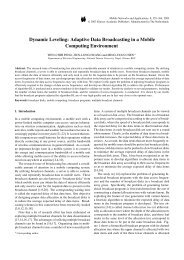
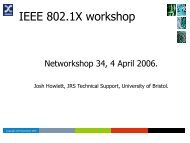

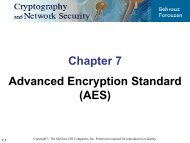
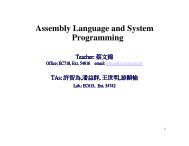
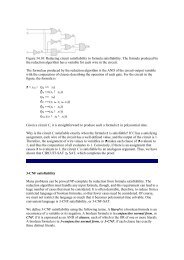
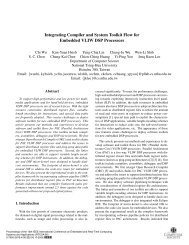
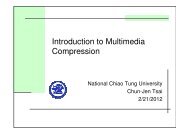
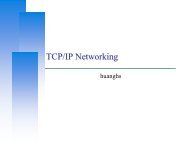
![Microsoft PowerPoint - 05_FTP.ppt [\254\333\256e\274\322\246\241]](https://img.yumpu.com/36298340/1/190x143/microsoft-powerpoint-05-ftpppt-254333256e274322246241.jpg?quality=85)
